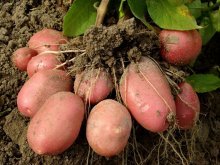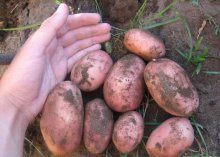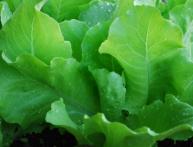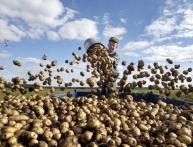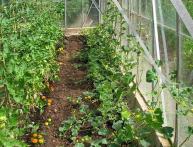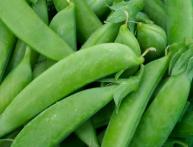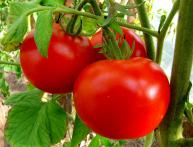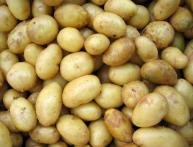Rosara potatoes: description of the variety, complete care from planting to harvest
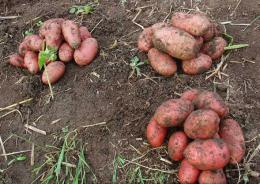
It is known from the school curriculum that Emperor Peter I brought potatoes to Russia from Europe. There the plant was also grown for a long time mainly as an ornamental plant. Potatoes were recognized as suitable for food already during the time of Catherine II, and then under Nicholas I.
This happened thanks to the Russian scientist A. T. Bolotov. Once, while visiting Germany, Andrei Timofeevich saw that the Germans were feeding piglets tubers, which were called tartufels and potatoes. Later he described potatoes with round white tubers as earthen apples, and he called pink oblong potatoes earthen pears.
Subsequently, both species took root and breeders worked on varieties with both white and pink tubers. Thanks to the efforts of German breeders, vegetable growers received pink rosara potatoes; a description of the variety can be found below.
Content:
- Description of the potato variety Rosara
- How to plant and grow Rosara potatoes
- Planting and caring for potatoes
Description of the potato variety Rosara
The rosara variety is suitable for vegetable growers who prefer early varieties with pink, pink-red tubers and creamy yellow pulp. Over the past two decades, the variety has remained popular for cultivation on farms and in personal backyards.
Due to the fact that 90-91% of the harvested tubers have a high marketability, the rosara variety is grown not only for personal needs, but also for sale. The big advantage of this variety is its early ripening. The harvest can be harvested within two to two and a half months after germination. Under each rose bush, the number of tubers on average exceeds 15 pieces.
Potatoes weighing from 85 to 115 grams are considered marketable. With conventional agricultural technology, 300 kg can be removed from one hundred square meters potatoes. With improved agricultural technology, you can get 500 kg from one hundred square meters. Rosara is characterized as a variety that produces a good harvest in any summer. The bushes of the variety are semi-spreading, the shoots are straight and of medium length. The flowers are violet-red.
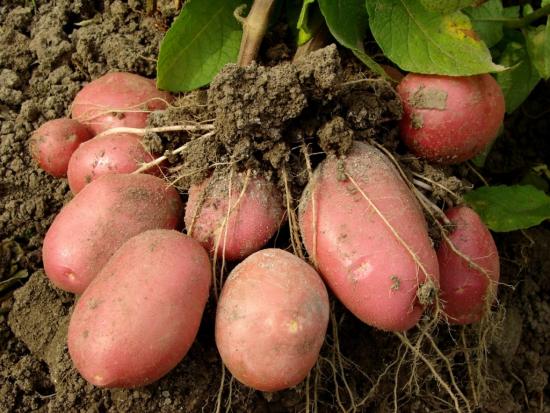
The advantages of the variety include:
- excellent taste for early potatoes
- a small number of eyes
- resistance to many diseases
- resistance to degeneration, can be grown for 5 years without replacement
- preservation of tubers when transported over long distances
The disadvantages of the variety can be called:
- requirements for seed potatoes; the best yield is obtained when planted with tubers weighing at least 50 g
- when planting at the end of May, harvesting may coincide with mid-season varieties
- to display varietal characteristics as an early variety, it is preferable to plant in those regions where planting of early varieties begins in late April - early May
- characteristic of early varieties low starch content from 12 to 16%, so it is better to use for frying or for dishes that require not soggy potatoes, for example, for preparing many winter salads
Despite its relative unpretentiousness, the variety still requires compliance with certain agricultural techniques when growing.
How to plant and grow Rosara potatoes
The process of growing potatoes can be divided into several stages:
- preparing seed potatoes for planting
- soil preparation
- landing
- care during growing period
- harvest
Description of the best potato varieties and their advantages in the video:
Preparing seed tubers and soil for planting
To prepare the tubers you need to do the following:
- expose to light 30 days before planting
- spread in 1-2 layers in boxes
- stand for two weeks at a temperature of + 18 + 20
- wait a week before landing at a temperature of +5 + 6 degrees
- Cut large tubers and dry the sections for several days
Soil preparation:
- dig or plow to a depth of 25 - 30 cm
- fill holes or grooves, the average depth in light soils is 10 - 15 cm, in heavy soils - 8 - 10 cm
- add 1-2 tablespoons of urea or wood ash directly into the holes
Planting and caring for potatoes
The planting process involves placing seed potatoes in holes or furrows. The distance between holes or tubers should not be less than 40 - 50 cm. After the tubers are laid out, they are covered with soil.
Basic care consists of removing weeds and hilling the bushes. The rosera variety is responsive to loosening the soil, so weeding and hilling can be done 2-3 times during the season. The interval between treatments is from 7 to 10 days. This will promote the formation of new roots and improve air access to them. Start processing soil it is necessary when the seedlings reach a size of 10 - 12 cm.
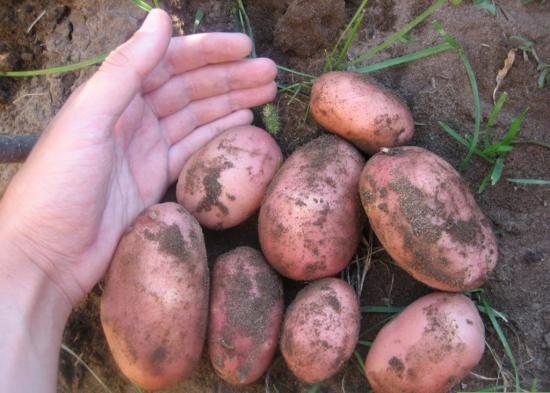
If there is a threat of frost, the sprouts can be almost completely covered with soil. Potatoes rarely require additional watering, but in case of drought, the bushes need to be watered; the amount of water per bush should not exceed five liters.In addition to all of the above, some potato growers recommend removing the buds of the Rosara variety; this technique increases the yield and reduces the time for tubers to ripen.
It is possible that in regions where potatoes are affected by the Colorado potato beetle or ladybird, mechanical destruction of pests or treatment of bushes with chemical control agents will be required. If the early potato bushes begin to fall apart and dry out, you can begin to harvest.
When digging up tubers of the Rosara variety, there is one advantage: all the tubers are placed almost immediately under the shoots and are almost not damaged by a pitchfork or shovel when digging. After the crop is dug up, after a few days it needs to be dried in a place protected from sunlight. Sort through, remove damaged tubers, they are eaten immediately. Separate the seed tubers. Store in a cool, dry cellar. In order to always have a potato harvest, it is advisable to plant at least 2-3 varieties.

